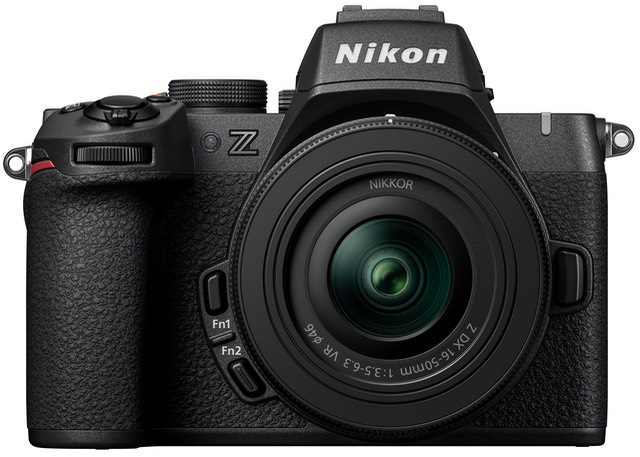
The Z50II is a significant update to Nikon's first generation APS-C mirrorless camera using the Z mount.
- Sensor: 20.9mp APS-C (DX)
- 23.5 x 15.7mm (DX)
- BSI (backside illumination) CMOS sensor
- no AA filter
- no sensor-based IS
- ISP: EXPEED7
- Mount: Nikon Z
- F-mount lens usage via optional FTZ adapter
- Images:
- Maximum size: 5568 x 3712 8-bit JPEG, 10-bit HEIF, or 14-bit NEF raw
- Aspect ratios: 3:2, 1:1, and 16:9
- Buffer: maximum 11 fps continuous with mechanical shutter (200 image 14-bit Lossless compressed raw buffer)
- 15 fps or 30 fps Pre-capture release available (JPEG only)
- Video:
- 4K/60/50P, (? Mbps internal), 1.5x crop
- 4K/30/25/24P (? Mbps internal), full frame downsampled
- 1080P/120/100/60/50/25/24 (? Mbps internal), full frame downsampled
- N-Log support
- H.265/HEVC 8-bit or 10-bit, H.264/MPEG4 8-bit with stereo PCM or AAC audio, MP4 or MOV container
- Electronic VR for video (some additional crop)
- HDMI clean output via connector at 8-bit 4.2.0 format for both HD and 4K
- HDMI jack is Type D
- Tally light
- microphone, headphone jacks
- Shutter:
- mechanical: 900 sec to 1/4000 sec, tested to 150k cycles
- electronic: 900 sec to 1/2000 sec
- bulb, time
- electronic front curtain option
- Exposure:
- matrix, center-weighted, spot metering, highlight-weighted metering
- -5 to +5EV exposure compensation
- 9 white balance settings (plus Auto and Custom), 2500 to 10,000K
- ISO 100-51200 (plus Auto,102400- 204800 boosts)
- Focus:
- 209-point selectable (231 auto) phase detect (covers 87% horizontal, 85% vertical of the frame) (-9EV to EV19 sensitivity with f/1.2 lens at base ISO)
- Area modes: pinpoint, single point, dynamic area, wide-area (small, large, custom), auto-area, 3D tracking
- Subject detection: People, Animals, Birds, Vehicles, Airplanes; also subject detect in manual focus
- manual focus override, touch focus, product highlight focus
- Rear Display: 3.2” touch LCD
- 1.04m dot
- articulating (180° outward), swivel (270°)
- Viewfinder:
- 2.36m dot OLED EVF, now 1000 nits (Z50 was 500 nits)
- 0.68x magnification
- -3 to +3m diopter adjustment
- 19.5mm eye point
- 60 Hz
- Flash:
- internal pop-up flash (GN 22', 7m)
- hot shoe, supports Nikon CLS (i-TTL)
- 1/250 flash sync (note that the internal flash has lower GN at 1/200 and 1/250)
- red-eye reduction, slow sync, rear sync, Auto FP, supports wireless flash
- Remote:
- optional ML-L7 wireless remote
- optional MC-DC3 wired remote (plugs into headphone jack)
- SnapBridge app
- Other Notable Features:
- Wi-Fi 802.11ac (5Mhz support) (SnapBridge or Nikon Wireless Transmitter Utility)
- Bluetooth 5.0 (SnapBridge)
- antiflicker reduction
- USB-C 3.2
- Cards:
- one SD slot
- UHS-II support
- Battery:
- EN-EL25a
- 230 to 270 shots CIPA
- USB charging
- does not come with charger
- Size:
- 5" (127mm) wide
- 3.9" (96.8mm) tall
- 2.7” (66.5mm) deep
- Weight: 19.4 ounces (550g) with battery card
- Colors: Black
- Price: US$910 body only, US$1050 including 16-50mm 3.5-5.6 VR DX lens
- Current Firmware: version 1.01 (April 2025)
- Announced: November 6, 2024
- Nikon's Marketing Slogan: Discover. Play.
- Nikon lenses for the Nikon Z50II
- Nikon's Web page for the Nikon Z50II
- Thom's Review of the Nikon Z50II (coming)
- Thom's Book for the Nikon Z50II (coming)
Support this site by ordering this product from the following advertiser:
